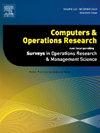The two-echelon vehicle routing problem with pickups, deliveries, and deadlines
IF 4.1
2区 工程技术
Q2 COMPUTER SCIENCE, INTERDISCIPLINARY APPLICATIONS
引用次数: 0
Abstract
This paper introduces the Two-Echelon Vehicle Routing Problem with Pickups, Deliveries, and Deadlines (2E-VRP-PDD), an emerging routing variant addressing the operations of logistics companies connecting consumers and suppliers in metropolitan areas. Logistics companies typically organize their logistics in such metropolitan areas via multiple geographically dispersed two-echelon distribution systems. The 2E-VRP-PDD is the practical problem that needs to be solved within each of such a single two-echelon distribution system, thereby merging first and last-mile logistics operations. Specifically, it integrates the distribution of last-mile parcels from the hub via satellites to the consumers with the collection of first-mile parcels from the suppliers via satellites that return to the hub. Moreover, it considers deadlines before first-mile parcels arrive at the hub, which must be transported further in the network. We solve the 2E-VRP-PDD with a newly developed Adaptive Large Neighborhood Search (ALNS) combined with a post-process integer programming model. Our ALNS provides high-quality solutions on established benchmark instances from the literature. On a new benchmark set for the 2E-VRP-PDD, we find that modifying time restrictions, such as parcel delivery deadlines at the city hub, can lead to an 8.27% cost increase, highlighting the overhead associated with same-day delivery compared to next-day delivery operations. Finally, by analyzing real-life instances containing up to 2150 customers obtained from our industry collaborator in Jakarta, Indonesia, we show that our ALNS can reduce the cost of operations by up to 17.54% compared to current practice.
带取货、送货和截止日期的两梯队车辆路线问题
本文介绍了带取货、送货和截止日期的两级车辆路径问题(2E-VRP-PDD),这是一种新兴的路径变体,用于解决大都市地区连接消费者和供应商的物流公司的运营问题。物流公司通常通过多个地理上分散的两级配送系统在这些大都市地区组织物流。2E-VRP-PDD是需要在这样一个单一的两级分配系统中解决的实际问题,从而合并了第一英里和最后一英里的物流操作。具体来说,它将最后一英里的包裹通过卫星从中心分发到消费者,并通过卫星从供应商收集第一英里的包裹,然后返回到中心。此外,它还考虑了第一英里包裹到达中心之前的最后期限,这些包裹必须在网络中进一步运输。我们采用一种新开发的自适应大邻域搜索(ALNS)结合处理后整数规划模型来解决2E-VRP-PDD问题。我们的ALNS在文献中建立的基准实例上提供高质量的解决方案。在为2E-VRP-PDD设定的新基准上,我们发现修改时间限制,如城市中心的包裹递送截止日期,可能导致成本增加8.27%,突出了与次日送达业务相比,当日送达的相关开销。最后,通过分析从我们在印度尼西亚雅加达的行业合作伙伴那里获得的包含多达2150个客户的实际实例,我们表明,与目前的实践相比,我们的ALNS可以将运营成本降低17.54%。
本文章由计算机程序翻译,如有差异,请以英文原文为准。
求助全文
约1分钟内获得全文
求助全文
来源期刊

Computers & Operations Research
工程技术-工程:工业
CiteScore
8.60
自引率
8.70%
发文量
292
审稿时长
8.5 months
期刊介绍:
Operations research and computers meet in a large number of scientific fields, many of which are of vital current concern to our troubled society. These include, among others, ecology, transportation, safety, reliability, urban planning, economics, inventory control, investment strategy and logistics (including reverse logistics). Computers & Operations Research provides an international forum for the application of computers and operations research techniques to problems in these and related fields.
 求助内容:
求助内容: 应助结果提醒方式:
应助结果提醒方式:


